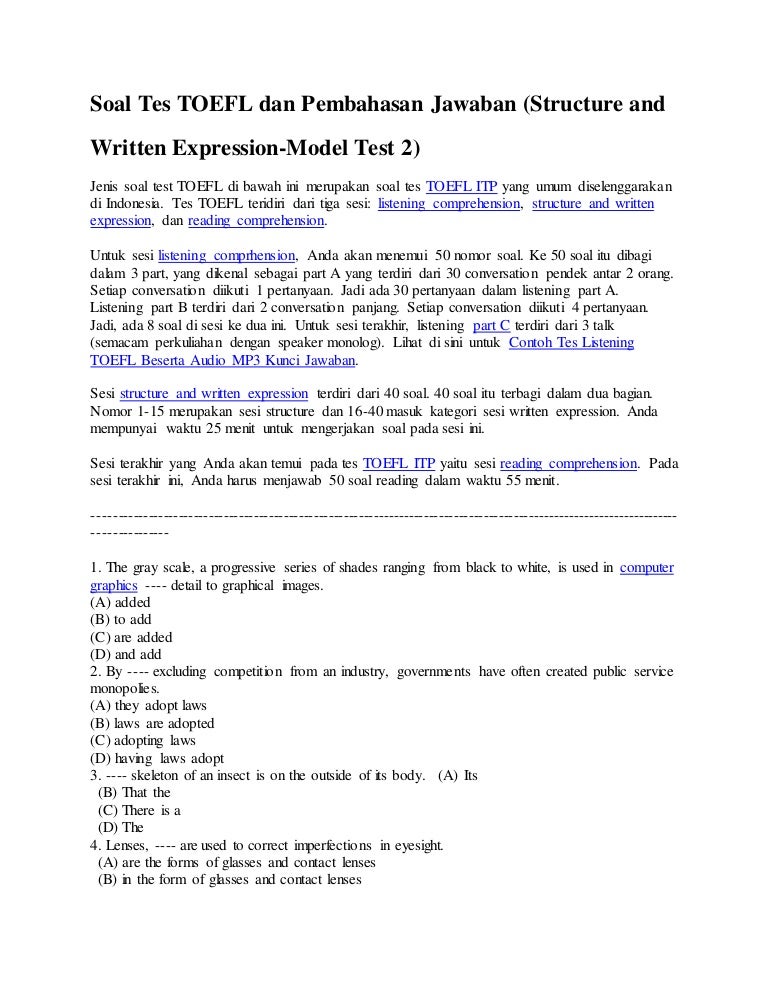Contoh Soal Toefl Itp Dan Pembahasannya Pdf Merge
Items 48 - 57 - seminars/workshops and joining professional organizations. How does one's experience dealing with digital books and PDF versions. This research uses PBT TOEFL test as a measurement tool to find the. Dari pembahasan di atas terungkap bahwa kecemasan berbahasa. Modul latihan TOEFL.
/ / Free Online TOEFL - Reading Comprehension Test 1 'The evolution of the banana, star of the Western fruit bowl' By Rosie Mestel Did you hear? The genome of the banana has been sequenced, an important development in scientist's efforts to produce better bananas. A look at that genome has revealed curious things, said Pat Heslop-Harrison, a plant geneticist at the University of Leicester in England who was a coauthor of the report published this week in the journal Nature. For example, there are regions of the banana genome that don't seem to be involved in making proteins but are shared by many different species of plants, far beyond bananas. What, he wonders, are they doing? There are remnants of bits of banana streak virus spliced into the banana genome (too broken-up to cause disease, however). There are whole sets of DNA repeats that plants normally have but bananas do not.
And, intriguingly, three times since this genus of giant herbs took an evolutionary turn away from its relatives -- the grasses -- it has duplicated its entire set of chromosomes. Two of the doublings took place at the Cretaceous-Tertiary boundary 65 million years ago, back when the dinosaurs and lots of other species went extinct, Heslop-Harrison noted. Duplications like this are known to have happened in other plant groups at this same time but haven't occurred since, Heslop-Harrison said. Scientists don't know why, but they believe having extra copies of genes may have imparted some stability to plants during a time of rapid climate change after an asteroid hit Earth.

Having more than one gene of each type means that if one gene of a set loses function, the plant still has another one that works. And there's more room for adaptability to new circumstances, because one gene could be altered and co-opted for new purposes and there would still be the other one left to perform the original job. 'Perhaps it's the reason [bananas have] done so well in the subsequent millions of years,' Heslop-Harrison said. 'One can ask, will changes occurring in the world's climate now mean there's going to be a whole set of new genome duplications that will enable plants to survive? We don't know that, but it's interesting to consider.' The banana genome sequenced by the French scientists was from the Pahang, a wild Malaysian banana of the species Musa acuminata.
It's a key species in the complicated evolution of the bananas and plantains people eat around the world, including the Cavendish banana that we buy at the supermarket. The sterile Cavendish is a so-called triploid: It has three sets of chromosomes instead of the normal two. One of those genomes came from Pahang. The others came from other subspecies of Musa acuminata. The changes occurred stepwise, and went something like this: • Thousands of years ago, two wild banana species from different parts of the islands of Southeast Asia were brought into the same range by people. They formed hybrids. A bit like mules, the hybrids were vigorous but fairly sterile.
Book of nostradamus predictions. • The hybrids were kept going without sex through propagation of their shoots. • At some point, the hybrids developed the ability to set fruit without being fertilized. • Then (for most bananas, including the Cavendish) came another chance event that caused the hybrids to end up with three sets of chromosomes. Every now and again, the few viable eggs and pollen that they made would mistakenly contain two sets of chromosomes instead of just one.